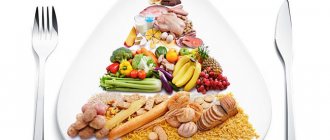Fractional nutrition is a diet in which a person eats often (every 3-4 hours), but in small portions. Proponents of fractional meals argue that if a person eats according to the classical scheme (three times a day), then in the intervals between meals, hormones that awaken appetite have time to be produced. As a result, when a person sits down at the table, he experiences a heightened feeling of hunger, and in this state he eats much more than he needs to be full.
Let's take a closer look at the basics of a fractional diet and find out which foods are most suitable for it. It is worth noting right away that this article is for informational purposes only. Everything stated in it is not a guide to action, but only a description and food for thought. Whether to use the described nutritional system in practice, everyone must decide for themselves, after consulting a doctor.
What is fractional nutrition and what are its benefits?
Most often, eating in fractional ways is called a diet, but in fact it is a special system of eating. The point is to divide the daily menu into 5-6 meals in small portions, which reduces the time gaps between meals. The longer the time period between meals, the more hunger-stimulating hormones are released into the blood.
Fractional meals are aimed at a gentle, gradual reduction in carbohydrate consumption due to proper planning of the daily diet and the prevention of accidental snacks. Over time, the body adapts to new small portions of food, the stomach becomes smaller, and it requires a small amount of food to be full.
This approach will prevent the body from excessive appetite and promotes fat burning due to the reduction in the number of calories consumed.
The efficiency of the power system lies in the following factors:
- small portions of food do not weigh down or overload the gastrointestinal tract;
- food is digested quickly and without obstacles;
- there is a feeling of lightness in the intestines;
- there is no dysbacteriosis;
- Weight gain is suppressed even in pregnant women when all the nutrients for the baby are supplied.
The walls of the human stomach are made of muscle fibers, so it is easily deformed.
This means that when you eat a lot of food, your stomach stretches. Over time, the organ grows in size, so a person needs an increasing amount of food to overcome the feeling of hunger. If you switch to eating in small portions, the volume of the stomach shrinks, which is why you need a small amount of food to be full.
The effectiveness of the method
When eating in fractional amounts, weight does not melt as quickly and intensively as when following a fast diet. In 20-25 days you will be able to lose 5-7 kg. Physical activity will help improve the effect. Over the course of a year, weight-bearing nutrition will help you lose 40 kg.
Losing weight will lead to the following results:
- the functioning of the gastrointestinal tract will improve;
- acceleration of metabolism;
- improving the condition of hair, skin, nervous system and nails;
- normalization of appetite.
The essence
The mechanism for losing weight on a diet by the hour is based on the benefits of eating small portions at small, regular intervals. This approach provides several important positive results, including:
- absence of the debilitating feeling of hunger characteristic of most low-calorie weight loss programs;
- reducing the amount of food consumed and reducing the calorie content of the daily diet, which is due to a decrease in appetite and the ability to control portion sizes;
- normalization of metabolism, more thorough digestion of consumed food and complete absorption of useful elements;
- clear organization of daily routine and nutrition, development of correct eating habits.
In addition, if you eat strictly at the same time every day, the body will get used to a specific schedule, will no longer be “afraid” of hunger and will put energy into reserves, because it “knows” that it will soon receive a new portion of calories. In addition, the organs of the digestive system, when the next scheduled intake of food approaches, begin to prepare and produce the appropriate enzymes, which has a beneficial effect on the digestion and absorption of nutrients.
At the same time, the number of meals and the time intervals between them, as well as the timing of the hourly diet may be different. The following options are considered the most effective:
- first diet - every 2 hours eat 100 grams exclusively of those dishes or products that are included in the list of permitted ones;
- second diet - eat 200 grams every 3 hours, eating the same dietary food.
Attention! If, to lose weight on a diet by the hour, you choose the first option, in which you need to eat after two hours, then during the day there will be 6-7 meals, which is very inconvenient for a student or working person. And if the second diet is used (every 3 hours), the menu will be the traditional 5 meals a day, which is optimal for busy people.
Both varieties of this technique are aimed at activating metabolism, since it is slow metabolism that most often becomes the cause of gaining extra pounds. Therefore, when choosing an hourly meal plan that is suitable for yourself, you should proceed from your lifestyle and your own capabilities.
There are also several options for the duration of weight loss on a diet by the hour. It can be followed:
- for many years, but it is extremely important to monitor the balance and completeness of the menu;
- until you get the desired result, and then switch to proper nutrition;
- alternating dietary and regular days according to the chosen scheme (5/5, 6/6, 7/7, 5/7, 5/10, etc.) also until the set goal is achieved, but, as a rule, 1–1.5 month.
Thus, the category of diets for weight loss by the hour includes a fairly diverse list of methods, united by one principle - nutrition according to a clearly established time schedule. Otherwise, they can vary significantly and be completely different, ranging from a very strict six-day express program to a very gentle alternation.
In addition, there is another type of hourly weight loss called the Golden Hour diet. It is completely different from the methods discussed above and does not have their advantages, since it involves a completely different nutritional pattern. Its rules are as follows:
- food should be taken once a day for 60 minutes at any convenient time, but always at the same time;
- during this period you can eat whatever you want, without any restrictions;
- During the rest of the day, you are only allowed to drink water, green tea or herbal infusions without sugar.
In many online sources, this diet is positioned as “a novelty in modern dietetics that allows you to easily, without breaking down, without harming your health and without the need to consult a nutritionist, lose 5–10 kg in a week.” But all this is absolutely untrue, since it cannot be easy to endure a day without food, even if you are then allowed to eat everything in unlimited quantities. In addition, this method of nutrition cannot be called harmless to health and allowed for use without the consent of a specialist. Moreover, it is unlikely that any doctor will approve such a technique. However, it has supporters and there are even positive reviews indicating very significant weight loss results. It is believed that in such a period of time it is impossible to eat enough to exceed the daily caloric intake, therefore an energy deficit is created and weight decreases.
In any case, for the most effective weight loss on a diet by the hour, it is important not only to eat healthy foods, but also to monitor their calorie content. The list of permitted ones includes:
- lean meat and fish, seafood;
- low-fat dairy and fermented milk products;
- chicken and quail eggs;
- bran, whole grain, rye bread;
- cereal porridge;
- non-starchy vegetables, herbs;
- unsweetened fruits and dried fruits, berries;
- nuts, seeds, honey;
- natural vegetable oils.
In between meals, you should drink 1.5–2 liters of still water, which will help speed up metabolic processes and remove accumulated waste and toxins. Salt should be kept to a minimum and sugar should be completely eliminated.
Important! Losing weight on a diet by the hour is most effective in cases where you need to get rid of a small amount of the last extra pounds. A fractional hourly diet can speed up metabolism, activate the burning of subcutaneous fat and prevent the formation of new deposits, which will quickly bring weight to an individual norm.
If you follow all the rules and the recommended menu, weight loss on average per month can be 7-8 kilograms. The result largely depends on the initial body weight and other characteristics of the body.
The principle of operation of fractional nutrition
The point of the system is to gradually reduce calorie intake. With long breaks between meals, the feeling of hunger increases, the “self-preservation mode” is triggered in the body, during which a layer of subcutaneous fat grows “in reserve.”
This is the main indicator due to which you cannot fast to lose weight. If you consume food regularly, hunger pangs will not occur, all food will be easily digested and will not settle in fat depots. Body weight will decrease, while the body will not go to extremes of hunger stress.
The operating principle of fractional power:
- frequent meals of small portions of food;
- no spontaneous snacking between meals;
- drinking large volumes of liquid;
- consuming a small fixed amount of calories per day;
- refusal to take harmful foods.
The method of eating small portions, according to gastroenterologists, helps fight colitis, gastritis and ulcers.
Water load
Balanced fractional meals for weight loss involve consuming a sufficient amount of liquid - up to 2 liters per day. In this case, the liquid can enter the body both in the form of pure water and in the form of fruit drinks, tea or soups. To improve digestive processes, it is recommended to drink a glass of water 30 minutes before meals.
Dietary restrictions for fractional meals
It is worth noting that fractional nutrition as such does not apply to rigid methods of combating excess body weight. Rather, it is a natural method of teaching the body to properly satisfy hunger in small portions. As a result, your overall well-being improves and your mood rises. Following the principles of fractional nutrition, you need to eat regular food containing the required amount of nutrients and micronutrients (vitamins, microelements), and the diet should be energetically complete. Give up “fast food”: French fries, hamburgers, chips, Coca-Cola - replace all this with nuts or dried fruits.
What should you eat during fractional meals?
Fractional meals (the menu for the week is presented later in the article) involves consuming all foods that are healthy for the body. You will have to give up fast food, snacks, smoked meats, seeds and alcohol.
The following products are considered the most suitable for losing weight and normalizing the digestion process:
- fresh vegetable salads without mayonnaise sauce;
- vegetables in any form;
- fruits;
- steamed or boiled porridges: wheat, barley, buckwheat, pearl barley;
- first courses: soups, okroshka, puree soups;
- steamed or boiled meat without skin;
- boiled, steamed or baked fish.
You need to minimize your consumption of the following foods:
- ripe bananas;
- dates;
- potatoes in any form;
- boiled or canned corn;
- baked goods, marmalade and chocolate;
- pasta and any pasta.
It is better to avoid salt altogether or reduce its consumption as much as possible. Instead of sunflower oil, you should use olive or sesame oil. Fried vegetables and meat should be replaced with steamed or stewed ones.
Step-by-step transition to fractional meals:
- During the first 2-3 days, portions are reduced gradually, and the number of meals remains unchanged.
- Further, the amount of food consumed at a time is reduced to 250 ml, and the number of meals increases to 5-6 times a day.
- 2 days after getting used to the new regime, you can start replacing products. Junk food is replaced by healthy food.
- You need to put food in small dishes in order to be satisfied with less food.
Mechanism of weight loss
Fractional nutrition is used not only by doctors to treat gastrointestinal diseases. Nutritionists suggest adhering to its basic principles for losing weight. Theoretically, weight loss is explained very simply and scientifically.
- Mode
The body gets used to the arrival of food at certain hours and prepares for this: juice is released in the stomach, salivation increases (all this contributes to the rapid and easy absorption of foods). A slight feeling of hunger appears strictly on an hourly basis, which eliminates the risk of unnecessary snacking and overeating.
- Frequency
With fractional meals it is impossible to overeat, because between such frequent meals (maximum 4 hours) hunger does not yet have time to wake up.
- Portion volume
You need to eat no more than 200-300 g of food at one time. This prevents your stomach from becoming full and significantly reduces your daily calorie intake.
- Product Set
All harmful (and they are most often high-calorie) foods are excluded, they are replaced by healthy and dietary ones.
So it is quite possible to lose weight on fractional meals, but in practice this does not always happen for the following reasons:
- incorrect transition (the body does not have time to rebuild, the stomach requires large volumes of food, which leads to breakdown and overeating);
- lack of physical activity;
- excessive daily caloric intake due to a large amount of carbohydrates in the diet;
- constant indulgences for yourself, your beloved, in the form of a piece of cake at night or a burger for lunch;
- individual characteristics of the body.
Calculation of daily calorie intake and nutritional supplements for fractional meals
Fractional meals (the weekly menu involves variations in food combinations) presupposes the correct ratio of nutrients consumed. To correctly calculate the ratio of proteins, fats and carbohydrates, you need to know the required standards.
On average the figure is:
| Belkov, % | Fat, % | Carbohydrates, % |
| 50 | 30 | 20 |
The proportions correspond to the principles of a balanced diet.
For gaining muscle mass, the proportions look like this:
| Belkov, % | Fat, % | Carbohydrates, % |
| 30 | 10 | 60 |
1 g of proteins contains 4 kcal, fats – 9 kcal, carbohydrates – 4 kcal. For example, fish contains from 50 to 300 kcal/100 g. Tuna is the most nutritious, so if you replace it with hake, then vegetables or buckwheat are served with it.
How to go?
It is very important to switch to fractional meals wisely, so that a sudden change in diet and a jump in daily caloric intake does not affect your health. Therefore, do everything gradually. Step-by-step instructions will help you avoid making mistakes.
Week 1
Step 1. The 3 main meals should always take place at the same time, changing which is strictly prohibited.
Step 2. Accurately determine the calorie content of the food you consume and the portion sizes that satiate you at the moment. For example, 2,000 kcal per day and 700 g per meal. Write them down.
Step 3. Eliminate frying - replace it with a grill if necessary.
Step 4. Eliminate 1 harmful product from the menu every day (see list below).
Step 5. Start walking every day for half an hour.
Step 6. Organize the correct drinking regime: bring the daily norm to one and a half liters.
An example of gradually eliminating harmful foods:
- on Monday we give up fast food;
- on Tuesday - from semi-finished products (store-bought frozen cutlets, dumplings, dumplings, pancakes, etc.);
- on Wednesday we remove carbonated drinks;
- on Thursday - fatty meat;
- on Friday we no longer eat sausage, sausages, etc.;
- on Saturday - sweets;
- On Sunday we say goodbye to sugar forever.
Week 2
Step 1. Reduce daily caloric intake by 200 kcal. Distribute it among meals.
Step 2. Include 1 snack (lunch or afternoon snack) in your diet.
Step 3: Reduce the size of each serving according to the new calorie calculation.
Step 4. Learn to determine the ratio of BZHU, create a menu for the week in accordance with it.
Step 5. Continue eliminating 1 harmful product every day.
Step 6. Refuse the elevator - give preference to the stairs. Walk several stops to work and home.
Step 7. Bring the daily drinking water intake to 2 liters.
Week 3
Step 1. Reduce daily caloric intake by 300 kcal. Distribute it among meals.
Step 2. Include one more snack in the diet and decide on the last, 6th time.
Step 3. Reduce portion sizes due to the new daily caloric intake.
Step 4. Start doing 15-minute exercises in the morning.
Step 5. Calculate more accurately how much water you need to drink per day, based on your own weight (30 ml per 1 kg). Organize your drinking regime accordingly.
Continue to work according to this scheme until the daily calorie content reaches 1,200 kcal (for women) and 1,500 (for men), the serving size becomes no more than 300 g (this is the maximum and only for lunch). But these parameters are for weight loss. If your goal is to maintain normal weight and switch to simple proper nutrition, then the numbers should be higher: 1,500 kcal and 1,800 kcal, respectively (possibly more, depending on the intensity of physical activity and individual parameters).
Rules for fractional meals
To effectively reduce body weight as a result of eating fractional portions, there are several rules.
For example:
- You need to eat 5-6 times a day with the same amount of calories as usual. On average, a person consumes 1200-1500 kcal per day three times, so the same caloric intake should be divided into 5-6 meals.
- Preventing hunger. If you feel hungry, you should immediately eat a small amount of porridge, any vegetable or fruit from the list, yogurt or tea with honey. The point is not to eat a lot, but to satisfy the feeling of hunger. You should not snack on sausages, sandwiches, candy or any other foods rich in carbohydrates.
Interesting! There is another known method of fractional nutrition, in which food is consumed 10 times a day, every 2 hours. This is convenient and will not allow hunger to manifest itself.
Is there any harm?
Some supporters of fractional diets abuse the regime, trying to snack on high-calorie foods. The result is overeating, heaviness in the stomach and excess weight. Doctors recommend that all patients with endocrine disorders treat split meals with caution. Their hormonal control is impaired and cannot cope with the regulation of metabolism. Women suffering from infertility and amenorrhea, as well as all persons with disruptions in protein and carbohydrate metabolism, will have to give up fractional meals.
Doctors warn about certain risks to dental health. Since food is consumed frequently during the day, natural acids are constantly released to digest it. This negatively affects the condition of the teeth and can lead to the development of caries. It is very simple to minimize the risks - take good care of your mouth and visit the dentist periodically.
Contraindications to the diet
Any restrictions and changes in diet have their limitations.
The fractional regimen is contraindicated for the following health problems:
- gastrointestinal pathologies, pancreatic dysfunction;
- diabetes mellitus of the first and second types, while you need to eat well, even if meals are divided into 5-6 times;
- liver and kidney failure;
- anemia – in this case, full portions are necessary to avoid exacerbation of the pathology;
- acute forms of viral diseases - during this period the body is especially weakened, and experiments with nutrition can negatively affect health.
It is important to remember that before starting the transition to a fractional diet, you must consult with a gastroenterologist or therapist. You should also take a blood test for hemoglobin, red blood cells, cholesterol and platelets 2-3 weeks in advance.
How to limit yourself in food
We must not forget about water, which is an integral part of fractional nutrition. The daily rate of water consumed should be at least 2 liters . If there is heavy physical activity, then the norm automatically increases.
Water is necessary for the body to function properly
It is better to drink water half an hour before a meal, and not earlier than an hour and a half after it. This is another trick. After all, once in the stomach, water takes up a certain amount of space. This way, the stomach will not be empty and will not send a signal to the brain about feeling hungry.
During a meal, there is little space left in the stomach, again due to water, so the feeling of fullness comes earlier . This eliminates the possibility of eating too much.
Advantages and disadvantages of the method
Fractional meals (a weekly menu helps to completely saturate the body with vitamins and minerals necessary for life) with a competent approach contributes to high-quality and proper weight loss. Eating food in fractional portions prevents you from starving, becoming exhausted and overeating.
Unlike other diets, when you return to your usual diet, the kilograms and fat will not return, but a slim and toned figure will remain.
The main positive aspects of the system:
- improving the food digestion system;
- cleansing the intestines of waste and toxins;
- normalization of gastrointestinal tract functions;
- restoration of the bacterial flora of the stomach and neutralization of dysbacteriosis;
- high-quality and sustainable disposal of extra pounds.
For the benefits to take full effect, it is important to be consistent and stick to your diet. You should sleep at least 8 hours a day and perform systematic physical activity. In addition to all the positive aspects described, restricting your diet may have disadvantages that cannot be ignored.
Disadvantages of the fractional method:
- The method is not suitable for people who are emotionally dependent on food. Such people do not know the norms in food, they eat often and a lot, and any stressful situation is accompanied by an extraordinary meal.
- With multiple meals, there is a possibility of consuming more food than before. If portions are reduced, psychological stress may appear due to malnutrition.
- Snacking may make your diet unbalanced.
- An inconvenience is the fact that those losing weight always need to be “on alert” so as not to miss meal times. This fact can cause difficulties for people working in offices, schools, factories and other places where there is no opportunity to have a snack. The only solution is to eat food that does not need to be heated: yogurt, apple, orange.
Superfluous and harmful
Some types of foods still need to be excluded from your diet when it comes to fractional meals. First of all, these are useless or even harmful products for the body.
These include:
- sweet and carbonated drinks;
- various confectionery products;
- chips, crackers and the like;
- foods containing high amounts of unhealthy fats (not counting fish, nuts and other sources of essential fats);
- foods fried in oil;
- all kinds of semi-finished products and canned goods.
Popular entry in the category: Dukan diet: Attack stage - allowed foods + table
Meal schedule
There are several types of menus on a fractional diet. It is important to understand that this method can be combined with any other diets: buckwheat, vegetarian, cabbage, egg, dividing the food volumes into 5-6 meals.
To see results, from the very beginning you need to accustom your body to a systematic balanced diet on a schedule:
- Breakfast must start no later than 7-8 am;
- first snack between 10 and 10.30 am;
- lunch should take place at 13-13.30 pm;
- repeat snack around 16-16.30 in the afternoon;
- dinner should start at 19.30;
- no later than 4 hours before bedtime, you are allowed to have a light snack.
Menu of the month
When developing fractional meals for weight loss, it is better to create a monthly menu from the first day. The menu must be strictly followed so that eventually this diet becomes a habit .
If you violate the established regime even once, the chances of the body getting used to it decrease, and the meaning of all the work done on yourself is lost. Now you will need to start all over again.
If a feeling of fullness does not occur, but, on the contrary, is constantly accompanied by a feeling of hunger, then the fractional nutrition menu is compiled incorrectly. There is no point in sticking to it and stretching out your torment for a whole month.
In order to achieve weight loss, the menu should be designed in such a way that no difficulties arise, especially the feeling of malnutrition. A person should always feel full so that there is no desire to eat something extra. This is why fractional meals supplement the main diet with snacks.
Menu for a fractional diet for a week, calorie content of dishes
Fractional meals are an effective and gentle way to lose extra pounds without stressing the body. The proposed menu for the week allows the body to receive the entire range of vitamins and minerals with a low calorie content.
Five meals a day
Eating food 5 times a day provides the body with a feeling of fullness without overeating. The calorie content of the dishes is indicated in brackets in the table, kcal/100g.
| Breakfast | 1st snack | Dinner | 2nd snack | Dinner | |
| Monday | Oatmeal with water (105), a handful of berries, a cup of coffee without sugar (2) | A pair of juicy carrot roots (32), carrot and apple salad without granulated sugar (104) | Stewed chicken fillet (125), vegetable soup without frying (43) | Low-fat cottage cheese (101), 250 ml tea without sugar with lemon (2), apple or orange (36) | Boiled chicken without skin (170), tomato-cucumber salad with 1 tbsp. l. olive oil (57) |
| Tuesday | Low-fat cottage cheese (101), banana (105), a glass of tea or weak coffee (2) | Orange or grapefruit (36) | Boiled rice (preferably without salt) (116), steamed fish steak with boiled vegetables (120) | Green apple (47), rosehip decoction (18) | Baked turkey without skin (121), slice of cheese, cucumber (13) |
| Wednesday | Oatmeal on water with 1 tbsp. l. natural honey (130) | Tea with walnuts (654), ½ grapefruit (42) | Vegetable soup without potatoes (116), boiled brown rice (116), steamed fish (130) | A serving of low-fat yogurt with fresh berries (53), coffee without milk (2) | Pork baked in foil (268), sliced peppers with cucumbers (40) |
| Thursday | Brewed muesli with milk (225), any fruit, a cup of herbal tea (2) | Low-fat plain yogurt (38) | Vegetable soup with herbs without meat (116), boiled veal (131), green peas (55), apple (52) | Cucumber salad with tomatoes and sour cream, a glass of rosehip infusion (3) | Boiled shrimp and squid(95), broccoli (28) |
| Friday | Slice of rye bread (259), boiled egg (115), fresh cucumber (13), tea (2) | Mint tea (8), grapefruit (42) | Mushroom soup (39), boiled chicken with vegetables (200) | Cottage cheese casserole with honey or fruit (240) | Fish baked with vegetables in a sleeve (62) |
| Saturday | Oatmeal (105), egg white omelette (30), cup of tea (5) | Low-fat yogurt (38), banana (105) | Boiled buckwheat porridge with beef (139), pepper and cabbage salad (45), tea (8) | A glass of low-fat kefir (38), an apple (14) | Boiled shrimp (95) with sliced cucumbers and tomatoes with herbs (20) |
| Sunday | Muesli with berries (225), glass of kefir (40) | 2 pcs. kiwi (61) | Boiled brown rice (110), vegetable casserole with veal (187), apple (14) | Boiled squid (122), a glass of freshly squeezed tomato juice (21) | Steamed fish cutlets (73), vegetable salad (67) |
When drawing up a weekly menu, it is important to adhere to important rules:
- the diet is prepared for a week and distributed by meals and days;
- carbohydrates are consumed for breakfast, and proteins for dinner;
- water, juices and tea are allowed in unlimited quantities;
- salt and seasonings are added in reasonable quantities, as they can retain fluid in the body and awaken appetite;
- It is better to boil, stew or bake fish and meat to avoid frying;
- vegetables should make up the bulk of the serving if they serve as a side dish;
- If buckwheat or rice is served as a side dish, then their volume should be equal to half the serving, along with meat and fish.
Six meals a day
| Breakfast | Lunch | Dinner | Afternoon snack | Dinner | 4 hours before bedtime | |
| Mon | Oatmeal with low-fat milk with berries and fruit slices, coffee with milk without granulated sugar | Orange or tangerine | Baked river trout, a mixture of stewed vegetables and a glass of tomato juice | Cottage cheese with dill and basil | Boiled pike with baked vegetables | A glass of kefir |
| W | Rye toast with cheese, fruit and berry smoothie with mint | Carrot or ½ grapefruit | Cream bean soup without cream, green hour with milk or honey | Curdled milk with whole grain bread | Boiled shrimp with herbs, sprinkled with lemon juice | handful of berries |
| Wed | Buckwheat with milk, black tea with honey | A glass of fruit smoothie or a glass of berries | Turkey fillet baked in foil, salad of tomatoes, cucumbers and herbs, a cup of tea | Cottage cheese casserole with herbs | Baked breast without skin with pumpkin | A glass of milk |
| Thu | Omelette of a couple of eggs, 2 loaves of bread, a glass of lemon-ginger tea | Green apple, fresh or baked | Steamed salmon, mixed vegetables and a glass of carrot juice | Protein cocktail | Grilled vegetables and trout steak | Linden tea or a glass of yogurt |
| Fri | Salad of oranges without veins, papaya and pineapples | Kiwi couple | Vegetarian borscht, steamed chicken fillet cutlets, fresh grapefruit | Greek yogurt with rye bread | Tomato salad with onions and cucumbers, steamed turkey fillet | A glass of kefir 1% fat |
| Sat | Boiled egg or omelette, grated carrots, freshly squeezed orange juice | Mandarin or apple | Creamy pea soup with vegetables, boiled chicken breast, tomato salad with herbs, tea | Fruit salad dressed with natural yoghurt | Steamed turkey cutlets, green salad with radishes | Herb tea |
| Sun | Oatmeal cooked with milk, raspberry or currant tea | 3-4 apricots or a couple of peaches | Spinach soup, grilled fish, cabbage and carrot salad, milk tea | Salad with peas and seafood | Fish baked in foil, cucumber and green onion salad | A glass of milk with 1 tsp. honey |
Recipes for fractional meals
Fractional meals, the weekly menu of which is presented as an example, are not strict like diets. Dishes can be easily varied to suit your own taste. Below are several recipes for dishes that can also be included in the diet.
A fresh vegetable salad
Low-calorie, fresh and nutritious vegetable salad is the basis of proper nutrition, as it saturates the body with vitamins and fiber.
Product set:
- ½ head of Chinese cabbage;
- crispy fresh carrots;
- avocado fruit;
- a couple of young cucumbers;
- a bunch of parsley with dill;
- a pinch of fine salt;
- 1 tsp. freshly squeezed lemon juice.
Step by step cooking method:
- Chinese cabbage is cut into small shavings.
- Carrots with avocado and cucumber are chopped into cubes.
- The greens are chopped.
- All products are mixed, sprinkled with salt and seasoned with lemon juice.
The salad is served as a snack, lunch or dinner.
Vegetable puree
Vegetable puree is rich in vitamins, is very easily absorbed by the body and starts metabolic processes. This dish can be offered not only to those losing weight, but also to people in rehabilitation and children.
Components:
- ½ cauliflower;
- 2 carrots;
- 1 sweet potato;
- 100 g cottage cheese;
- any greens to taste;
- a pinch of salt and freshly ground black pepper.
Step-by-step method for preparing light vegetable puree:
- All vegetables from the list are boiled and peeled.
- Slice and place in a blender bowl.
- Add chopped herbs and cottage cheese.
- The mass is salted and beaten until smooth.
For taste, add 1 tsp when serving. yogurt or a sprig of basil.
Cold cucumber soup
Refreshing and dietary cucumber soup is perfect for satisfying your hunger in the summer heat without overloading your stomach.
Product set:
- 1 kg of young cucumbers;
- lemon or lime fruit;
- 4-5 mint leaves;
- a handful of sesame seeds;
- 200 g shrimp.
Cooking recipe in stages:
- Young cucumbers are peeled using a vegetable peeler and blended with a blender.
- Lemon is added along with zest and mint, and everything is mixed again.
The dish is served with boiled shrimp and sesame seeds dried in a frying pan.
Fractional nutrition is one of the most useful and effective systems of food consumption, which helps improve well-being and weight loss. A properly designed menu for the week and physical activity will help you lose 40 kg per year, establish the proper functioning of your body systems and feel great every day.
Products: permitted and prohibited
You can put an equal sign between the concepts of “fractional nutrition” and “rational nutrition”. Only healthy food will reinforce the positive effect of eating on a split schedule. Therefore, you will have to exclude all “harmful” foods from your diet:
- fast food category dishes;
- quick dishes “from the street” - fried pies, pasties, shawarma, hot dogs, burgers;
- products containing trans fats - cakes and pastries with butter cream, margarine, ketchups and spreads;
- baked goods made from white flour - buns, white bread, milk loaves;
- packaged instant food - pasta, soups, con-broths;
- sweets and dairy products containing dyes, flavors and flavor enhancers - yoghurts with additives, candies, chewing marmalade, chocolate bars;
- sweet carbonated drinks;
- meat products - pates, sausages, frankfurters, sausages, various smoked meats.
What should be in the diet of a person who eats rationally and fractionally:
- greens and vegetables - bell peppers, broccoli, asparagus, cauliflower, cucumbers, garlic, ginger, onions, tomatoes, sweet potatoes, green beans;
- fruit and berry variety - apples, bananas, avocados, blueberries, strawberries, citrus fruits are considered the healthiest;
- cereal products - oats, buckwheat, brown rice, lentils, beans;
- seeds and nuts - almonds, coconut pulp, walnuts, cashews, peanuts, flaxseed, sesame;
- sweets – dark chocolate, multi-grain baked goods;
- animal products - eggs, natural yogurt, butter, whole milk, chicken, beef and lamb;
- seafood - salmon, sardines, shellfish, shrimp, trout, tuna.
With such a list of permitted products, there will be no questions about how to create a menu. Don't forget to include vegetable oils in your diet - sunflower, olive and coconut.











